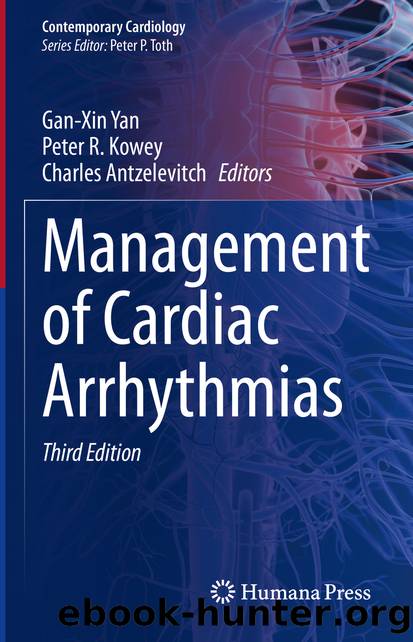Management of Cardiac Arrhythmias by Unknown

Author:Unknown
Language: eng
Format: epub
ISBN: 9783030419677
Publisher: Springer International Publishing
The main limitations of these catheters include frequent ectopy during mapping, transient injury of the superficial conduction system, limited maneuverability, poor tissue contact and lack of tissue contact information, and increased potential for thrombus formation with the need for careful anticoagulation and the additional cost.
Activation Mapping
In patients with hemodynamically stable monomorphic tachycardia, activation and entrainment mapping are the gold standards for localization of the best site for catheter ablation [79, 80].
Activation mapping is performed by recording local electrograms from multiple sites during VT aided by 3D mapping systems, which display the position of the catheter and relative timing of activation on the EAM system. For focal VTs, the earliest presystolic site of activation identifies the SOO and is the target of ablation. At this site, the local bipolar electrogram precedes the surface QRS onset, and the unipolar signal exhibits a QS configuration, consistent with a spread of activation away from the SOO.
In patients with SHD, the most common VT mechanism is scar-related reentry with continuous excitation of the circuit throughout the tachycardia cycle length (CL). Electrograms at exit sites, when activation mapping is performed during VT, are identified during the latter half of electrical diastole, frequently just before the QRS complex. Ablation at exit sites from the isthmus can terminate the tachycardia; however, it can also result in a change of the tachycardia configuration and/or cycle length, in which case the diastolic pathway can exit at different locations from the scar [78].
Ablation of the diastolic pathway “isthmus” is therefore a more desirable target, given it can eliminate the machinery required for reentry. Electrograms at isthmus sites occur earlier during diastole, are typically of very low-voltage amplitude (<0.5 mV), and can have multiple potentials consistent with more marked delayed conduction.
In general, an activation map of a VT circuit should demonstrate entrance, isthmus, and exit sites that serve as essential parts of the circuit, such that it cannot continue without all of these elements. It is not uncommon in nonischemic substrate that part of the circuit has an intramural component that might not be recorded on the surface. These usually exhibit a “gap” in the activation sequence, such that part of the circuit is “concealed” from the surface map, residing deep in the myocardium (Fig. 19.7).
Download
This site does not store any files on its server. We only index and link to content provided by other sites. Please contact the content providers to delete copyright contents if any and email us, we'll remove relevant links or contents immediately.
| Administration & Medicine Economics | Allied Health Professions |
| Basic Sciences | Dentistry |
| History | Medical Informatics |
| Medicine | Nursing |
| Pharmacology | Psychology |
| Research | Veterinary Medicine |
Tuesdays with Morrie by Mitch Albom(3830)
Yoga Anatomy by Kaminoff Leslie(3697)
Science and Development of Muscle Hypertrophy by Brad Schoenfeld(3574)
Bodyweight Strength Training: 12 Weeks to Build Muscle and Burn Fat by Jay Cardiello(3348)
Introduction to Kinesiology by Shirl J. Hoffman(3297)
How Music Works by David Byrne(2521)
Sapiens and Homo Deus by Yuval Noah Harari(2406)
Coroner's Journal by Louis Cataldie(2097)
Insomniac City by Bill Hayes(2080)
The Plant Paradox by Dr. Steven R. Gundry M.D(2036)
Churchill by Paul Johnson(2006)
Hashimoto's Protocol by Izabella Wentz PharmD(1894)
The Chimp Paradox by Peters Dr Steve(1857)
The Universe Inside You by Brian Clegg(1807)
The Immune System Recovery Plan by Susan Blum(1687)
Don't Look Behind You by Lois Duncan(1661)
The Hot Zone by Richard Preston(1630)
Endure by Alex Hutchinson(1601)
Woman: An Intimate Geography by Natalie Angier(1579)
